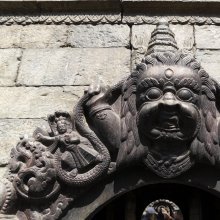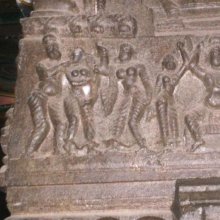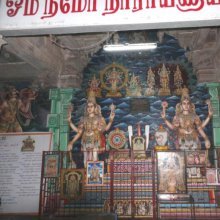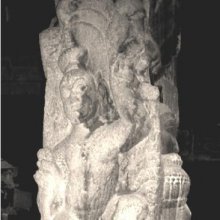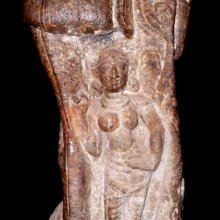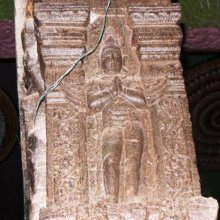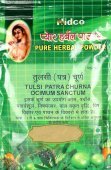Seeing, See: 1 definition
Introduction:
Seeing means something in Hinduism, Sanskrit. If you want to know the exact meaning, history, etymology or English translation of this term then check out the descriptions on this page. Add your comment or reference to a book if you want to contribute to this summary article.
Images (photo gallery)
(+258 more images available)
In Hinduism
Yoga (school of philosophy)
Source: ORA: Amanaska (king of all yogas): A Critical Edition and Annotated Translation by Jason BirchSeeing (the highest reality) is denoted in the Sanskrit language as Darśana, according to the Haṭhapradīpikā of Svātmārāma: an influential 15th-century Sanskrit manual on Hatha-Yoga dealing with techniques to channel one’s vital energy.—Accordingly, “Giving up sense objects is difficult to achieve; seeing the highest reality (tattva-darśana) is [also] difficult, and [so too] is attaining the natural state [of Samādhi], without the compassion of a true Guru”.

Yoga is originally considered a branch of Hindu philosophy (astika), but both ancient and modern Yoga combine the physical, mental and spiritual. Yoga teaches various physical techniques also known as āsanas (postures), used for various purposes (eg., meditation, contemplation, relaxation).
See also (Relevant definitions)
Query error!
Full-text (+80671): Darshana, Prekṣaṇa, Cakshus, Vilokana, Vikshana, Darshin, Darshaka, Drishti, Drashtri, Ikshana, Avaloka, Aloka, Pratyakshadarshana, Preksha, Sarvadarshin, Nidhyana, Pashya, Duradarshana, Nibhalana, Drashtukama.
Relevant text
Search found 664 books and stories containing Seeing, See, The seeing; (plurals include: Seeings, Sees, The seeings). You can also click to the full overview containing English textual excerpts. Below are direct links for the most relevant articles:
Shurangama Sutra (with commentary) (English) (by Hsuan Hua)
The false view of individual karma < [Chapter 2 - The Two False Views]
The eye entrance < [Chapter 3 - The Six Entrances]
The Tathagata shows that the seeing is the mind < [Chapter 1 - The Seeing Nature]
Chandogya Upanishad (Shankara Bhashya) (by Ganganatha Jha)
Section 7.24 (twenty-fourth khaṇḍa) (two texts) < [Chapter 7 - Seventh Adhyāya]
Section 5.1 (first khaṇḍa) (fifteen texts) < [Chapter 5 - Fifth Adhyāya]
Section 7.12 (twelfth khaṇḍa) (six texts) < [Chapter 8 - Eighth Adhyāya]
Maha Prajnaparamita Sastra (by Gelongma Karma Migme Chödrön)
Buddhas of the present: Preliminary note (3) < [Part 7 - Seeing, hearing and understanding all the Buddhas of the present]
Preliminary note to liberations, masteries and totalities < [Class (5) liberations, (6) masteries and (7) totalities]
III. The two kinds of irreversible Bodhisattvas (avaivartika) < [X. Surpassing the lower vehicles and acceding to the irreversible ground]
Tattvasangraha [with commentary] (by Ganganatha Jha)
Verse 1551-1553 < [Chapter 19b - (B) On analogical cognition]
Verse 2229 < [Chapter 24a - The case for the reliability of the Veda (the Revealed Word)]
Verse 1559-1560 < [Chapter 19b - (B) On analogical cognition]
A Survey of Paramattha Dhammas (by Sujin Boriharnwanaket)
Chapter 15 - The Nature Of Vipaka < [Part 2 - Citta]
Chapter 2 - The Buddha < [Part 1 - General Introduction]
Chapter 1 - The Natural Way Of Development < [Part 6 - Dialogue on Vipassanā]
Visuddhimagga (the pah of purification) (by Ñāṇamoli Bhikkhu)
Knowledge of Rise and Fall—I < [Chapter XX - Purification by Knowledge and Vision of the Path and the Not-path]
The Four Functions < [Chapter XXII - Purification by Knowledge and Vision (ñāṇadassana-visuddhi-niddesa)]
The Eighteen Principal Insights < [Chapter XX - Purification by Knowledge and Vision of the Path and the Not-path]
Related products
(+19 more products available)
